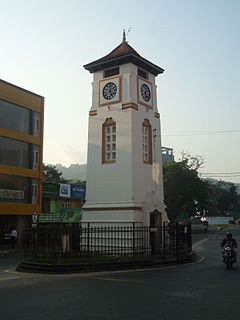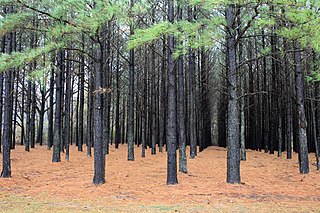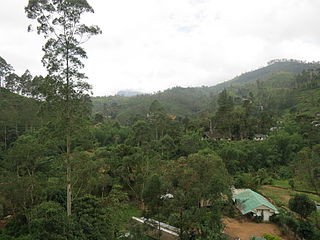
Nuwara Eliya is a city in the hill country of the Central Province, Sri Lanka. Its name means "city on the plain " or "city of light". The city is the administrative capital of Nuwara Eliya District, with a picturesque landscape and temperate climate. It is at an altitude of 1,868 m (6,128 ft) and is considered to be the most important location for tea production in Sri Lanka. The city is overlooked by Pidurutalagala, the tallest mountain in Sri Lanka. Nuwara Eliya is known for its temperate, cool climate – the coolest area in Sri Lanka.

Hatton is a town in the Nuwara Eliya District of Central Province, Sri Lanka governed by the Hatton-Dickoya Urban Council. Hatton is a major centre of the Sri Lankan tea industry.

Dehiwala-Mount Lavinia, population 245,974 (2012) is the largest suburb of the City of Colombo, and covers an extent of 2109 hectares. It lies south of the Colombo Municipal Council area and separated from it by the Dehiwala canal which forms the northern boundary of DMMC. Its southern limits lie in Borupana Road and the eastern boundary is Weras Ganga with its canal system and including some areas to its east. This town has extensive population and rapid industrialization and urbanization in recent years. It is home to Sri Lanka's National Zoological Gardens, which remains one of Asia's largest. Colombo South Teaching Hospital, Kalubowila and Colombo Airport, Ratmalana are some important landmark in this area. Dehiwela-Mount Lavinia and Sri Jayawardenapura Kotte being two large suburban centers of the city of Colombo function together as one large urban agglomeration in the Region. The overspill from the City in residential and commercial uses of land have rapidly urbanised these suburban centers. Dehiwela-Mount Lavinia and Sri Jayawardenpaura along with Colombo Municipal Council form the most urbanized part of the core area of the Colombo Metropolitan Region. Dehiwala and Mount Lavinia lie along the Galle Road artery, which runs along the coast to the south of the country.
General Ranjan Wijeratne was the former Sri Lankan Minister of Foreign Affairs, Minister for Defence and Minister of Plantation Industries from 1989 to 1991 in the Premadasa cabinet.

Badulla is the main city of Uva Province situated in the lower central hills of Sri Lanka. It is the capital city of Uva Province and the Badulla District.

Indian Tamils of Sri Lanka are Tamil people of Indian origin in Sri Lanka. They are also known as Hill Country Tamils, Up-Country Tamils or simply Indian Tamils. They are partly descended from workers sent from South India to Sri Lanka in the 19th and 20th centuries to work in coffee, tea and rubber plantations. Some also migrated on their own as merchants and as other service providers. These Tamil-speakers mostly live in the central highlands, also known as the Malayakam or Hill Country yet others are also found in major urban areas and in the Northern Province. Although they are all termed as Tamils today, some have Telugu and Malayalee origins as well as diverse South Indian caste origins. They are instrumental in the plantation sector economy of Sri Lanka. In general, socio-economically their standard of living is below that of the national average and they are described as one of the poorest and most neglected groups in Sri Lanka. In 1964 a large percentage were repatriated to India, but left a considerable number as stateless people. By the 1990s most of these had been given Sri Lankan citizenship. Most are Hindus with a minority of Christians and Muslims amongst them. There are also a small minority followers of Buddhism among them. Politically they are supportive of trade union-based political parties that have supported most of the ruling coalitions since the 1980s.

The Sri Lankan independence movement was a peaceful political movement which was aimed at achieving independence and self-rule for the country of Sri Lanka, then British Ceylon, from the British Empire. It was initiated around the turn of the 20th century and led mostly by the educated middle class. It succeeded when, on 4 February 1948, Ceylon was granted independence as the Dominion of Ceylon. Dominion status within the British Commonwealth was retained for the next 24 years until 22 May 1972 when it became a republic and was renamed the Republic of Sri Lanka.

Sri Lankan place name etymology is characterized by the linguistic and ethnic diversity of the island of Sri Lanka through the ages and the position of the country in the centre of ancient and medieval sea trade routes. While typical Sri Lankan placenames of Sinhalese origin vastly dominate, toponyms which stem from Tamil, Dutch, English, Portuguese and Arabic also exist. In the past, the many composite or hybrid place names and the juxtaposition of Sinhala and Tamil placenames reflected the coexistence of people of both language groups. Today, however, toponyms and their etymologies are a source of heated political debate in the country as part of the political struggles between the majority Sinhalese and minority Sri Lankan Tamils.

Christianity is a minority religion in Sri Lanka. Christianity was introduced to the island in first century, probably in AD 72. Traditionally, after Thomas the Apostle's visit in Kerala in AD 52, Christianity is said to have been introduced via India because of its close geographical and commercial ties. According to Christian traditions, the apostle Thomas preached the Gospel in Sri Lanka. Records suggest that St. Thomas Christians and Nestorian Christians lived in Sri Lanka. Anuradhapura cross is one of the archaeological claims that suggest Christianity in Sri Lanka before Portuguese. Roman Catholicism was introduced by the Portuguese in 1505. There were conversions by Dutch persons in the 17th century, which resulted in a percentage of church members in excess of 10%.

Alves is a small agricultural village in Moray, Scotland.

Charles Henry de Soysa was a Ceylonese entrepreneur and gentlemen philanthropist. He was a pioneering planter, industrialist and was the wealthiest Ceylonese of the 19th century. He was instrumental in the establishment of the first Ceylonese bank, the Moratuwa carpenters guild, the Ceylon Agricultural and National Associations. He is widely regarded as the greatest philanthropist of the island for contributions which includes the De Soysa Maternity Hospital, the Prince and Princess of Wales Colleges, St. Matthias Church, the Model Farm Experimental Station and many other institutions and acts of charity, establishing infant-maternal healthcare and secular education for girls in the country. He was the country's first Knight Bachelor (posthumous).

Haputale is a town of Badulla District in the Uva Province, Sri Lanka, governed by an Urban Council. The elevation is 1431 m (4695 ft) above the sea level. The area has a rich bio-diversity dense with numerous varieties of flora and fauna. Haputale is surrounded by hills covered with cloud forests and tea plantations. The town has a cooler climate than its surroundings, due to its elevation. The Haputale pass allows views across the Southern plains of Sri Lanka. The South-West boundary of Uva basin is marked by the Haputale mountain ridges, which continue on to Horton Plains and Adam's Peak to the west. CNN in 2010 named Haputale as one of Asia's most overlooked destinations.

Orange Field Tea Factory is engaged in the manufacture of Black tea catering to the Middle - Eastern market and the C-I-S Countries. The factory is situated in Panwilatenne, a very small hamlet in Kandy District, Sri Lanka and located within close proximity to Loolecondera Estate where tea was planted for the first time in the Island by James Taylor (Ceylon). Established in the year 1950 the factory produces Black Tea from leaves grown by about 750 small plantation holders in the westen medium elevational category, at an altitude of between 650 meters to 1000 meters above sea level. Orange Field Tea Factory is registered with The Sri Lanka Tea Board and also is a member of the Ethical Tea Partnership. The average annual production for the past few years has been 500,000 kg. The produce is sold weekly at the Colombo tea auctions conducted by the Colombo Brokers' Association, monitored by the Colombo Tea Traders Association.

Coffee production in Sri Lanka peaked in 1870, with over 111,400 hectares being cultivated. The Dutch had experimented with coffee cultivation in the 18th century, but it was not successful until the British began large scale commercial production following the Colebrooke–Cameron Commission reforms of 1833. By 1860, the country was amongst the major coffee-producing nations in the world. Although coffee production remains a source of revenue, it is no longer a main economic sector. In 2014, the country ranked 43rd of largest coffee producers in the world.

Tea production is one of the main sources of foreign exchange for Sri Lanka, and accounts for 2% of GDP, contributing over US $1.5 billion in 2013 to the economy of Sri Lanka. It employs, directly or indirectly, over 1 million people, and in 1995 directly employed 215,338 on tea plantations and estates. In addition, tea planting by smallholders is the source of employment for thousands whilst it is also the main form of livelihoods for tens of thousands of families. Sri Lanka is the world's fourth-largest producer of tea. In 1995, it was the world's leading exporter of tea, with 23% of the total world export, but it has since been surpassed by Kenya. The highest production of 340 million kg was recorded in 2013, while the production in 2014 was slightly reduced to 338 million kg.
H Cannappen Velusingham Velupillai was a Ceylonese trade unionist, politician and poet.
Richard Charles Kannangara was a Ceylonese tea plantation owner and politician.
Evelyn Charles Arthur Villiers JP UPM was a British planter and politician in colonial Ceylon.
Lieutenant Colonel Derrick Nugawela was a Sri Lankan army officer, planter and banker.






















